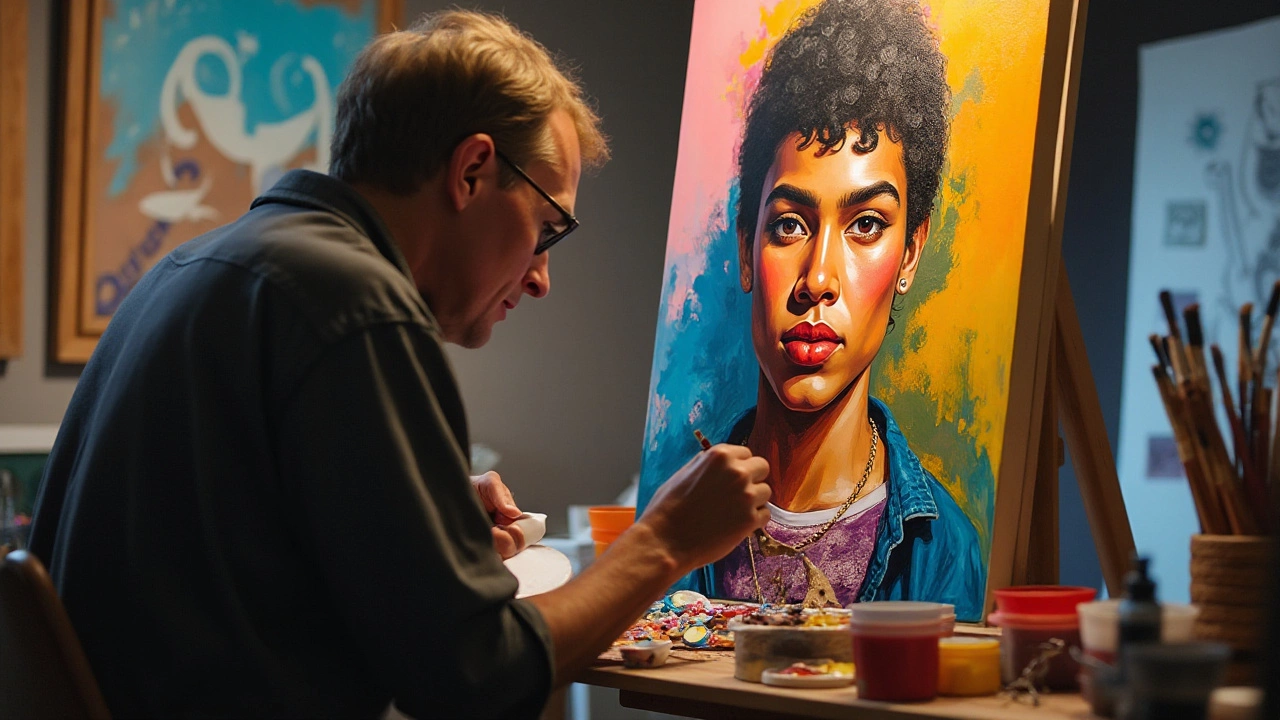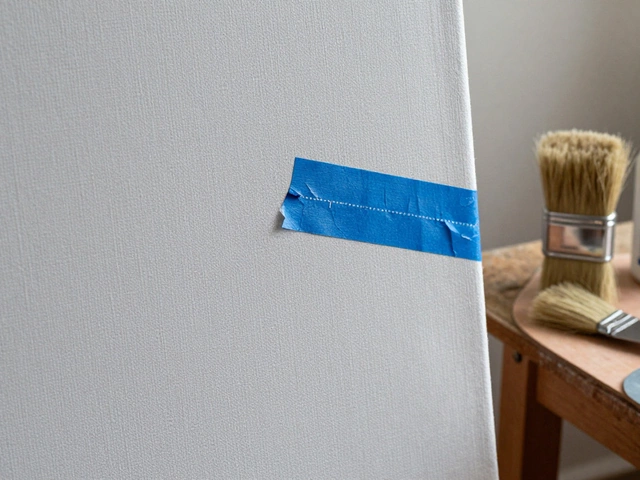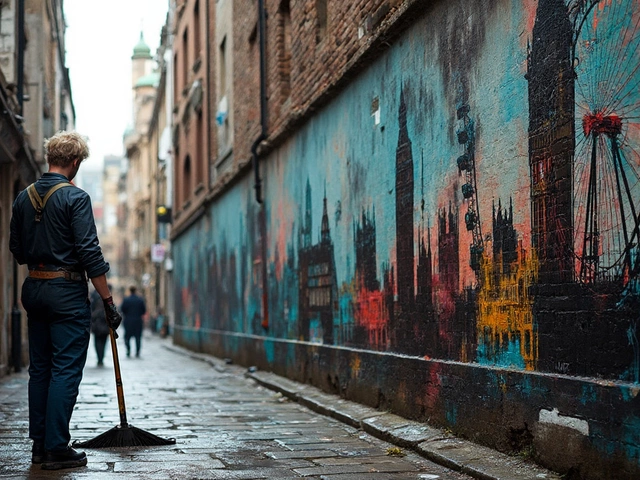Painting a portrait isn't just about capturing a likeness; it's about expressing the soul and character of the subject through the medium you choose. The type of paint you select plays a significant role in bringing your vision to life. Each kind of paint, whether it's oil, acrylic, or watercolor, has its own personality and set of benefits that can transform your approach and result.
For many, oil paint represents the classic route, offering deep, rich hues and a leisurely drying time that’s perfect for those lingering touches. In contrast, acrylic paint is renowned for its quick drying and flexibility, allowing for fast layering and vibrant color. Then there's watercolor, valued for its delicate washes and transparency that add an ethereal quality to portraits.
Understanding these subtle differences can greatly influence your technique and enhance your skill. As you embark on your artistic journey, knowing the characteristics and applications of each type of paint will empower you to make the best choice for each unique portrait you create.
- Understanding Paint Types
- Oil Paint: Traditional Excellence
- Acrylic Paint: Modern Versatility
- Watercolor: Subtle Elegance
- Choosing the Right Surface
- Practical Tips for Beginners
Understanding Paint Types
When it comes to the art of portrait painting, the type of paint you choose can be both a reflection of your style and a tool to achieve different effects. There are three primary kinds of paint most commonly used in portraiture: oil, acrylic, and watercolor. Each has its own traits and historical allure, offering artists a palette of possibilities. The choice often depends on your technique, level of expertise, and the vision you have for your piece. Oil paint, cherished for its versatility and rich texture, has been the go-to medium for many master painters over the centuries. Its slow drying time allows for intricate detailing and blending, making it ideal for portraits where depth and realism are desired. Notably, the Mona Lisa was painted with oils, showcasing its capability to endure through ages.
Acrylic paint, a relative newcomer in the grand history of painting, has roots in the 20th century. It’s praised for its adaptability and quick drying properties, allowing artists to layer colors rapidly and adjust elements in swift succession. Acrylics can mimic the opacity of oils or achieve watercolor-like transparency, depending on dilution and application techniques. This versatility is why it is often preferred by contemporary artists looking to push boundaries and techniques in portraiture. The vividness of its pigments means that subjects can become striking and bold on the canvas, commanding attention and detail.
Watercolor, known for its airy lightness and fluid movement, offers a different kind of charm. This paint type is celebrated for its ability to create subtle gradations and its capacity for transparency, allowing colors to blend in soft, dreamlike ways. It’s this quality that can bring a sense of delicacy and motion to portraits, depicting emotions through gentle washes and layers. Yet, the mastery of watercolor may require a strong hand and a softer touch, proving challenging yet rewarding for those patient enough to hone their craft. A fascinating aspect of watercolors is their historical connection to sketching and preparatory work, offering glimpses into artists' contemplative processes.
"Oil paints allow for an unparalleled richness and depth that truly captures the essence of a subject," commented art historian Henry Fielding in one of his lectures on classic painting techniques, emphasizing the enduring appeal of oil paints in portraiture.Understanding these various paint types and their properties can greatly enhance one's artistry. By experimenting with each, artists can discover new methods to breathe life into their subjects. Ultimately, the best paint for a portrait is one that aligns with the artist’s vision and the specific emotion or story they wish to convey through their work. In managing the drying times, employing different layering techniques, and choosing substrates, artists often consider both the technical and expressive outcomes these choices offer. As these factors interlace, they form the very fabric of the portrait—a celebration of identity captured on canvas.
Oil Paint: Traditional Excellence
Oil paint has been the trusted companion of artists for centuries, admired for its lushness and unparalleled depth. It holds a revered place in the history of art, from the masterpieces of the Renaissance to the bold strokes of the Impressionists. There's something almost magical in the way oil paint can capture the minute details of a portrait, while offering a richness that other paints struggle to match. The slow drying time is a distinctive feature, allowing artists to mix, dab, and rework areas as ideas evolve on the canvas. For many, this translates into creative freedom, where each stroke becomes part of a conversation between the artist and their subject. This extended wet-on-wet flexibility is a significant reason artists are drawn to oils: it allows for an extended play, a merging of colors that seamlessly blend without the need for hasty decisions.
One fascinating fact about oil paints is their composition. Known for its binding agent, linseed oil, it's the choice often attributed to their enduring luster. However, new combinations using walnut or poppyseed oils offer varying effects—each suited to different needs. The pigments suspended in these oils are vibrant and bold, resulting in colors that can stay unchanged for decades if not centuries when preserved correctly. There’s a certain gravitas to using oil paints; it commands attention with its thick and creamy texture, demanding a commitment that often draws a more meditative process from its painter.
Historically, artists such as Leonardo Da Vinci and Rembrandt van Rijn have relied on oils to create their timeless works. That adherence to tradition is not just about technique but about experiencing the often enigmatic connection between the artist and their tools. The celebrated portrait artist John Singer Sargent once said,
"A portrait is a painting with something wrong with the mouth."This tongue-in-cheek homage underscores the idea that oil portraiture is as much about the pursuit of perfection as it is about capturing imperfections that define us.
When working with oil paints for portrait painting, preparation is key. Start with a well-primed canvas to prevent absorption and ensure longevity. It's also useful to have an assortment of brushes, as the texture and strokes can vary drastically with oil's thickness. Damping a brush with turpentine can create beautiful, delicate transparencies, while those wide, bristle brushes are perfect for sweeping gestures. You may also appreciate the benefits of using a limited palette, where mastery of mixing can help achieve a harmonious blend, reflecting light and shadow in compelling ways.
If you’re considering acrylics or watercolors, it’s worth giving oil paints a try at least once to experience their distinctive strengths. The opportunity to engage with history, to partake in techniques developed by some of the world’s greatest artists, can add immeasurable depth to your artistry. And while the cleanup is more cumbersome—requiring solvents rather than simple water—the results invariably tend to justify the means, especially when your portrait finds that rare, elusive voice of expression only oils can offer.

Acrylic Paint: Modern Versatility
When it comes to portrait painting, acrylic paint is like the chameleon of the art world, offering a flexibility and range that can adapt to nearly any style or need an artist might have. Developed in the mid-20th century, acrylics have revolutionized the way artists approach their canvases, being both a favorite for contemporary painters and a tool for learning different techniques due to their forgiving nature. The fast-drying time is perhaps their most compelling feature, enabling artists to work at a quicker pace without the long waiting times associated with oils. With a multitude of colors and textures available, acrylics invite creativity and experimentation. The wide accessibility of the paint also makes it an attractive choice for both beginners and established artists exploring portrait painting.
Acrylics dry quickly to a waterproof finish, which means multiple layers can be achieved in a single sitting. This is particularly advantageous when an artist is keen to adapt or correct a composition swiftly. Additionally, the paint's water-solubility when wet allows for easy mixing and cleaning, but once dry, it becomes remarkably durable. Thus, an acrylic portrait is well-prepared to endure time and handling without significant deterioration. For artists working in humid conditions or en plein air, this fast-drying aspect can be a double-edged sword, so some schemes include retarders to slow drying time, providing a buffer for blending and modifying.
The versatility doesn’t stop there—acrylics can mimic other mediums. Adding a bit of water can give them a consistency similar to watercolors, with a washed-out effect. On the opposite spectrum, they can be applied thickly, like oils, using impasto techniques that create texture and depth. With the introduction of various mediums and additives, the possibilities are endless, from gloss and matte finishes to an array of textures. According to renowned artist Sharon Sprung, "Acrylics give you that quick fix of satisfaction when building up textures, especially for those dynamic backgrounds and intricacies in clothing that just pop."
Sprung asserts that the flow of acrylics from highly fluid to buttery thick not only enhances the artist's freedom but also fosters innovation in every session.
For the modern portrait artist, incorporating acrylics can mean embracing both new and old techniques. These paints provide a vibrant color palette that holds intensity even when diluted. This is essential when capturing the emotion and life within a portrait—it allows the artist to portray subtle skin tones and highlights convincingly. With the ability to be applied on various surfaces, whether canvas, wood or paper, acrylic paint offers another layer of flexibility. They’re less sensitive to temperature and humidity, ensuring a more stable finished product, which is invaluable for artists exhibiting or selling their work. Surprisingly, acrylics are not only robust but also kinder on the wallet compared to oils, making them an attractive starting point for those new to portraiture.
An intriguing perspective on acrylic paint is its environmentally friendly nature. Traditional oil painting requires solvents like turpentine, which can be harmful to both the environment and the artist's health. In contrast, the non-toxic options available with acrylics provide an eco-friendly alternative that many environmentally conscious artists prefer. This characteristic adds yet another layer to its versatility, not just in the painting environment but also in contributing positively to sustainable practices within the art world.
Watercolor: Subtle Elegance
Among the various mediums available for portrait painting, watercolor stands out due to its unique blend of subtlety and expressiveness. This medium, often favored by artists seeking to capture the ethereal and translucent qualities of their subjects, allows for a distinct and emotive portrayal. Watercolor paintings are known for their delicacy, creating soft transitions and gentle hues that seem to breathe life into each brushstroke. The fluid nature of watercolor enables artists to achieve effects that are hard to replicate with other paints, such as soft, dreamy backgrounds and wispy details, lending a serene and contemplative mood to portraits.
The use of watercolor in portrait painting requires a mastery of light and layering, since the paint's transparent nature exposes the canvas beneath and layers of color built upon one another. This delicacy demands an understanding of how light and color interact. Colors blend seamlessly, permitting a sophisticated play of shadows and highlights. The transparency also means that mistakes are less forgiving, requiring foresight and precision from the artist. Still, it is this very challenge that attracts many to watercolors, encouraging them to develop a technique that anticipates the behavior of the paint and exploits it to portray the subtle nuances of human expression.
To add to the allure of watercolor portraits, many artists embrace its unpredictability. The fluid paint can create unexpected effects, contributing to the painting's uniqueness. Indeed, it is often said, "Watercolors give the artist the gossamer quality of the moment—fleeting and dreamlike, an instant captured in time." Experimenting with different water-to-paint ratios and brushes changes how each stroke sits on the paper, leading to discoveries that keep the medium exciting. It is also common to see watercolorists manipulating the paper—tilting it or painting on wet versus dry surfaces—to achieve different saturations and effects, offering endless creative possibilities.
Portrait artists interested in using watercolor must also consider their choice of paper. A heavyweight paper with minimal absorbency is often preferred to support layers of watercolor without buckling. The texture chosen—ranging from coarse to smooth—can also dramatically alter the texture and mood of the finished piece. The connection between the medium, the paper, and the artist's technique forms the essence of watercolor painting, making every portrait an interaction of skill, chance, and material.
Choosing watercolor as a medium for portraits requires a blend of patience and spontaneity, as the art form teaches practitioners the value of embracing imperfections as well as planning. It also provides a versatility that allows the artist to explore a vast range of expressive possibilities. Whether capturing the soft blush of a cheek or the distant gaze of an eye, the elegant and subtle nature of watercolor encourages artists to see and interpret their subjects in new, meaningful ways.

Choosing the Right Surface
Choosing the right surface is as crucial as selecting the perfect paint when it comes to portrait painting. Each surface can significantly impact the texture and finish of your artwork. The three most common surfaces used by artists today are canvas, paper, and wood panels, each offering distinct advantages and challenges depending on the type of paint you prefer. Understanding these differences can substantially improve your craft.
Canvas
Canvas is perhaps the most traditional choice for many painters, serving as a favorite for those working with oil and acrylic paints. It provides a robust yet flexible surface that can handle heavy layers and detailed brushwork. Typically available in a range of textures from smooth to rough, it allows for vast artistic expression. Artists appreciate canvas for its durability and the way it accommodates vibrant colors, making it ideal for capturing the depth and rich hues essential in portrait painting. Many historical portraits, celebrated for their enduring beauty, owe much of their preservation to the resilient nature of canvas.
Paper
For those working with watercolors or pastels, paper is often the preferred surface. It offers a light, portable option that can absorb pigment differently than other surfaces. This absorption allows watercolors to create fluid, translucent effects, ideal for building layers and creating subtler details in a portrait. It's essential to choose high-quality, acid-free paper to ensure longevity, especially given how moisture can affect this medium. The texture of paper can also add a unique dimension to your artwork, influencing how the paint or pigment behaves under your brush.
Wood Panels
Wood panels provide a sturdy surface that has been used by artists for centuries, offering a rigid foundation that prevents the warping or bending often seen with other materials. This option is particularly favored for its smoothness, which allows for more intricate detail work. Wood panels can be a perfect choice for oil paints, as the oils bond beautifully with the wood’s fibers, creating a lasting finish. They can also provide a contemporary feel, sometimes favored by modern artists for their sleek foundation and ease of handling and transporting.
"The key to choosing a surface for painting isn’t just about compatibility with the paint, but also about achieving the desired permanence and texture in your work," says renowned art critic Jonathan Jones.
Deciding on the right surface often requires experimentation to see what suits your technique, style, and preference. By exploring these options, artists can enhance their control over texture and composition, tailoring each piece with the desired surface to bring their portrait subjects to life in vibrant, lasting detail.
Practical Tips for Beginners
Embarking on the journey of portrait painting can be exciting but also overwhelming. One of the initial hurdles is choosing the right paint that aligns with your creative goals. Start by exploring different types of paints—oil, acrylic, and watercolor. Each of them brings its unique attributes to the canvas. Oil paints, revered for their blendability and richness, demand patience as they dry slowly, which can be both a blessing and a challenge. Acrylics dry fast, making them suitable for quick performers and those who enjoy layering, while watercolors offer a level of control and subtlety often unmatched by other paint types.
Understanding Your Medium
The first practical tip is to spend time understanding what each type of paint can offer. Oils can intimidate beginners due to their perceived complexity, but they are remarkably forgiving. Their slow drying time allows for plenty of room to self-correct and build layers of depth. Acrylics, although quick-drying, can be watered down to mimic watercolor effects, offering versatility. Watercolors, on the other hand, rely heavily on the paper's quality and the water-to-paint ratio, teaching you precision and control.“Every artist was first an amateur.” – Ralph Waldo Emerson





